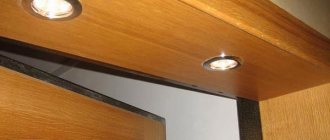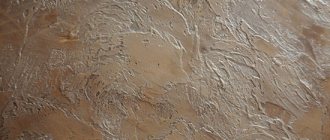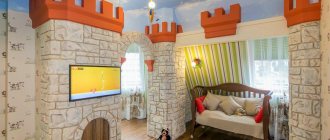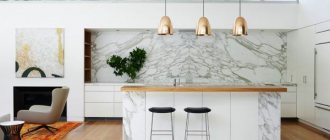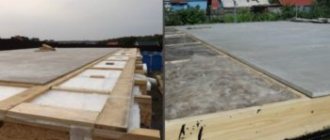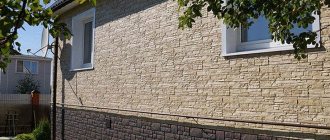The new role of such flooring as laminate deserves attention, since when it is installed on the walls, it is possible to obtain an original, unexpected sound from the interior that is familiar to us. In this article we will talk about how laminate on the wall can significantly transform the space of a room, adding a touch of freshness and individuality to it.
Laminate in the interior looks very fashionable and modern
Features of the material
Today, designers are increasingly choosing flooring materials as finishing materials. Laminate flooring on the walls in the hallway (a photo of the finished work is presented below) today is often installed in apartments and private houses. This is an interesting option that provides a lot of design possibilities.
Today, laminate flooring is available for sale, which differs in color, texture, and a number of other characteristics. It allows you to give the living room interior an unusual, interesting appearance. Before starting work, you need to familiarize yourself with the basic qualities of the material. This will avoid mistakes.
You can experiment. You can choose different types of laminate or cover the surface with the same type of panels. Layout patterns may also differ. The choice depends only on the preferences of the home owners. In addition to natural wood, laminate can imitate a number of other coatings. This could be stone, leather or other decorative surfaces.
Features of laminate wall finishing
Modern panels perfectly replicate the color and texture of wood, stone, leather and other natural surfaces. You can create a fashionable design using laminate on the walls of any space except the bath, where elevated temperature and humidity will quickly render the slats unusable.
Wall decoration with laminate will help create a unique, stylish interior in the living room
Such an original and environmentally friendly finish allows you to implement interesting ideas for decorating walls in the hallway. Various options for laying panels: horizontally, diagonally, vertically - add a unique look to the space.
Advice! Remember that horizontal laying of laminate panels will help visually expand the space. In rooms with a small height, the slats are mounted vertically, this slightly “raises” low ceilings.
A partition finished with laminate ideally separates the living room from the living room and creates a cozy atmosphere
Laminate finishing replaces wall panels, MDF, which require more material and physical costs. Such repairs are considered “clean” and of high quality, and the result is even, smooth walls. This affects the improvement of sound insulation of the room.
Laminate can be moisture-resistant and water-resistant. The first type has a unique composition, and its locks are treated with wax, which additionally protects the panels from liquid ingress. The second type, waterproof, as the developers claim, is suitable even for the bathroom. Such a laminate can not absorb moisture for several hours, even when completely flooded. For wall decoration, this material characteristic is not so relevant. But in the kitchen it is worth using a material that can not change from exposure to moisture and temperature changes.
Only moisture-resistant laminate is suitable for kitchen premises
Advantages
Decorating walls with laminate has become widespread due to the many positive qualities of this material:
- Wear resistance: designed for heavy loads, such material can last much longer when used on walls;
- Practicality: repairs to walls with laminate are carried out less often, as if they were covered with wallpaper;
- Ease of installation: even a non-specialist can decorate the interior with this material, but first you need to level the walls;
- Affordable cost: low-grade slats are suitable for walls, since with such finishing the top layers of the panels will practically not be erased;
- Easy care: laminate has antistatic properties, it is easy to care for, just wipe occasionally with a slightly damp cloth;
- Large selection: among the many options, you can choose the right one for wall decoration.
Thanks to the laminate on the walls, the interior becomes very warm and cozy
As for the environmental friendliness of the material, it is better to trust well-known brands that carefully monitor the quality and safety of their products, minimizing the concentration of harmful substances. Today, high-quality laminate must comply with the generally accepted standard E1, which does not limit the use of finishing in residential premises. Such panels are not inferior in safety to parquet boards.
Warm shades of laminate boards help create a comfortable indoor environment
Flaws
It is worth noting the disadvantages of laminate. Firstly, this is the requirement for almost perfectly smooth walls for gluing lamellas. Otherwise, you won't get an even canvas. Secondly, you should not use the material for all walls. This finish looks very active; it is better to choose it for decorating some surfaces.
Laminate is ideal for accenting a specific wall
Advantages
When deciding to install laminate flooring on the walls in the hallway (photo below), you should weigh all the advantages and disadvantages of such a solution. The presented finish has a number of advantages. Laminate is more durable than PVC or MDF panels. Therefore, upon impact, it will not bend or break.
The surface does not absorb moisture, which is especially important in the hallway. This becomes possible due to the presence of a polymer layer on the surface of the panels, as well as a dense structure. At the same time, clean the surface using a regular soapy detergent.
In addition, laminate flooring provides a wide range of design options. This is an environmentally friendly material. It does not release toxins into the environment. Installation is not difficult. Even a novice master can handle this work. At the same time, it will be possible to create an original interior with minimal effort and time. If we compare laminate with natural wood, which it usually imitates, we can note that it costs less. At the same time, laminate flooring is more resistant to adverse environmental factors. These are the main advantages of the material.
Pros and cons of using laminate to decorate corridor walls
Among the advantages of wall decoration are:
- high-quality material, which is much denser than MDF;
- does not absorb water;
- a huge range of colors and textures;
- ecologically pure;
- Even a beginner can handle the installation;
- protects other layers of wall covering from moisture;
- the walls look expensive;
- the development of fungus and mold is excluded;
- easy to maintain and use, does not attract dust and dirt;
- durable;
- in order to restore it to its former shine, it will be enough to wipe with a napkin;
- There are both budget options and more expensive ones.
The material is often used to decorate walls in the corridor.
Despite the fact that wall covering has a large number of advantages, you should not remain silent about the disadvantages.
A variety of colors allows you to turn unusual design solutions into reality.
Disadvantages of the design of laminate wall decoration in the hallway photo:
- expensive material;
- requires a solid base on which it will be mounted, because it is heavy;
- does not tolerate temperature changes;
- artificial material, and this is what repels most;
- Requires a perfectly flat surface for installation;
- If water remains on it for a long time, it cannot be repaired.
One of the most affordable materials is suitable in a situation where the owner wants to carry out wood finishing at minimal cost.
It is not recommended to install in rooms with high humidity levels.
Flaws
Laminate on the wall in the hallway interior looks impressive. However, it is worth paying attention to some of the disadvantages inherent in the presented type of finish. The cost of laminate is higher than that of MDF or PVC panels. Therefore, repair costs will increase significantly.
In addition, in order to install laminate flooring on walls, the base must be strong enough. The surface must be flat, otherwise installation will become noticeably more complicated and the end result will be unsatisfactory. Although, at first glance, the finishing seems light, this is far from the case. In order for the laminate to adhere well to the wall, the surface must be durable.
It is also worth considering the performance characteristics of the material. It should not be susceptible to temperature changes. If the hallway is constantly damp, cheap types of panels may become deformed. They will need to be additionally treated with a special sealant. This also increases the cost of repairs.
The most interesting and best design examples
When choosing, you should give preference to a material that will differ from the floor. Light-colored material - milky, light gray - will look more comfortable. If you still want to make dark-colored walls, we recommend that you use large mirrors that will visually enlarge the space, especially if the corridor is small.
Laminate allows you to create unique design solutions.
For wall coverings you can use any type of panels. An original solution is to decorate a niche with laminate, which will be decorated with soft pillows and a small sofa.
A great option for decorating a place where you and your guests can gather comfortably.
A dark-colored laminate will make the room even smaller, so using it in a small hallway is impractical.
Laminate has long ceased to be an exclusively flooring material, having become a universal solution for finishing any interior elements.
Laminate flooring in a vintage-style hallway will look out of place. But at the same time, it goes well with such styles as: English, minimalism, ontoart, loft, Provence and country.
In combination with other materials it will help create a unique, cozy and beautiful interior design.
Please note that a large amount of laminate should not be laid in one room, because it may feel like you are in a bathhouse. Corridor lighting is important.
Laminate on the wall in the interior is an unusual and inappropriate use that deserves attention.
When combining wood and white, you can create a cozy and stylish hallway. Very often they decorate one corner of the hallway with laminate, and the rest of the space with another coating.
Finishing walls with laminate requires relatively simple preparatory work, and the result exceeds all expectations.
Laminate is a universal material with which you can realize the most interesting design ideas.
Waterproof or moisture resistant?
Decorating the walls in the hallway with laminate and MDF panels has a number of differences. The first of these materials looks more aesthetically pleasing. Laminate manufacturers provide a huge selection of shades and textures. MDF has fewer design options.
You can choose a laminate that is waterproof or moisture resistant. These are two different types of materials. The moisture-resistant type of finish has a special composition. Its locks are treated with wax. This additionally protects the material from moisture getting inside. This option is most suitable for the hallway. Here water can get onto the finishing surface, but in small quantities. Therefore, a moisture-resistant laminate would be more appropriate here.
The waterproof type of finish is suitable even for a bathroom or bathhouse. It does not absorb moisture that remains on the surface for several hours. Of course, such material will last longer, but its cost is much higher. Therefore, not every owner of a house or apartment will decorate the walls in the hallway with waterproof laminate. Conventional types of material will not be suitable in this case. In the hallway, non-moisture resistant laminate will quickly become unusable.
Advantages and disadvantages of wall mounting laminate flooring
Before deciding on the possibility of attaching a laminate to the surface of the walls in a house or apartment, you should analyze the advantages and possible disadvantages of such a solution.
| Advantages | Flaws |
| High material strength under impact loads | Higher cost compared to wood wall panels |
| Dense structure and surface polymer layer providing sufficient resistance to moisture | The need for preliminary careful leveling of surfaces when gluing |
| Easy care, allowing you to use standard cleaning solutions | Insufficient resistance to temperature changes |
| Wide range of shades, textures with imitation of various materials | When mounted on a batten, a significant amount of space is lost, which limits the possibility |
| Environmental safety, durability, and resistance to fungal infections | Use in small spaces |
| Availability of self-installation, requires a minimum set of tools | When installing in bathrooms and other wet rooms, a powerful hood is required |
Decorating Tips
The decision to decorate the walls in the hallway with laminate is very practical. Installation work must be performed correctly. The cheapest laminate flooring is not suitable for this room. It is necessary to purchase material that is characterized by a high class of wear resistance. Only in this case the finish will be durable.
There are different design options that are relevant for such a room. You can finish the walls and floor with laminate, which will imitate wood. Other design options also look interesting. For example, you can finish only the bottom of the walls with laminate. The top is covered with wallpaper, painted or plastered. You can do the opposite. The walls in the hallway with laminate and decorative bricks will look impressive if the upper part of the walls is decorated with decorative panels. Below, a masonry of decorative bricks is created.
There are finishing projects that involve creating decoration from decorative stone in combination with laminate. In some cases, the emphasis is on only one wall. You can finish it with a laminate that will imitate wood or stone. You can hang lamps along the length of such an accent wall. The light flux will be directed downwards. This will create an interesting decorative effect. The hallway will resemble a medieval castle.
Laminate for finishing different rooms
Designers do not recommend completely covering all walls with material. This option is more suitable for country cottages and guest houses. More often, this material is used to highlight part of a room, for example, by zoning or creating an accent canvas. Let's look at what laminate looks like on the walls of different rooms.
Hallway
Laminate for a hallway is a more practical choice than the original one. Of course, decorating walls with such material can look stylish, but its qualities such as wear resistance and durability are important here. Additionally, the slats are coated with protective compounds. Such a wall will be easy to wash and clean as needed.
In the hallway it is better to choose laminate flooring in different shades of wood.
This material is interesting because it has many imitations of natural wood and stone in different color shades. Here you can combine different wall design options: decorate the entire surface or just the bottom, and cover the top of the walls with wallpaper to match. You can make one of the walls an accent by completely covering it with a laminate imitation of dark stone or wood. Several opaque lamps with beams directed up and down are hung along the length of such a wall. This design creates the atmosphere of a medieval castle in the hallway.
Before starting installation work, it is worth cleaning the walls, as well as creating a special substrate or covering made of cork so that the laminate has good air exchange here. Look at the photo for modern ideas for decorating walls in the hallway.
Laminate is glued to a perfectly flat surface
Kitchen
In the kitchen, laminate is most often used as an apron over the work surface. Its color is matched to the facades of the kitchen unit. In terms of its properties, such a coating will not be inferior to ceramic tiles, especially since you can choose panels that imitate ceramics, marble, and granite. But it is easier to install and cheaper in cost. Caring for such a kitchen apron is easy. A wall with such panels in the dining area looks impressive. Laminate imitating wood fits seamlessly into country style kitchens.
Different techniques for gluing laminate on walls create voluminous textured patterns
Living room
In the living room, laminate can become a tool for zoning. With the help of panels, part of the room is highlighted in the same way as when using combined wallpaper. For example, the area where there is a TV, a fireplace, and armchairs is often designed this way. The option looks interesting when such material, laid on the floor, goes on to the wall in a narrow strip.
Finishing the fireplace with laminate in the living room gives the spirit of the Middle Ages
Bedroom
The fashion for wall laminate flooring has not escaped the bedroom either. Such a room, decorated with wood, turns out to be rich and sophisticated. Partial paneling is also used here. For example, a wall made in this way behind the head of the bed and decorated with lighting will look cozy and stylish.
A bedroom with laminate walls is ideal for a comfortable sleep
Balconies and loggias
There are options in which the walls of balconies and loggias are finished with laminate, making their interiors feel cozy like rooms. By laying additional layers of thermal insulation material under the panels and installing radiators, you can get a small warm space. Here you will not need to worry about the effect of moisture on the boards.
Wooden finishing of balconies is very often used lately
Color
It is worth noting that laminate flooring on the wall in the hallway of a Khrushchev building will look harmonious only if the color is chosen correctly. The visual impression of the room depends on this. Light colors allow you to make a small corridor with an entrance hall visually more spacious. Dark shades, on the contrary, visually reduce the space.
Laminate shades are divided into cold and warm. You cannot mix these two types when creating finishes. The color scheme may contain shades of green, red, brown, blue and other colors. It is necessary to select tones in accordance with the existing interior.
The shade of the laminate can be matched to the color of the furniture or other walls. Sometimes the finish contrasts with them. Depending on the design, both options will be appropriate. It is also worth paying attention to the brightness of the colors. It depends on this whether the laminate will clearly contrast with the rest of the interior or whether it will simply become an unobtrusive background for the furniture in the hallway. Contrast is only possible in one group of shades. Also, the color is sometimes matched to the tone of the floor or front door.
Photo in the bathroom
Laminate on the walls in the bathroom interior can only be used if there is ventilation, which is important for the durability of the structure. Not suitable as an alternative to tiles in the shower area, but you can highlight one wall with wood trim.
Design tips
It is quite advisable to decorate the walls in the hallway with light laminate if the room is very small. In combination with the right lighting, the interior will look very harmonious.
If you plan to decorate an entire wall with a dark laminate, you should choose light, plain wallpaper for subsequent finishing. You can also paint the walls beige, milky, or light yellow. The choice depends on the tone of the dark laminate.
Dark plaster looks impressive with white laminate. It can also be a rich shade, for example, purple, burgundy, etc.
To create the illusion of endless space, not only the walls but also the floor are covered with laminate. Moreover, the material in this case must be of the same type. Although many designers argue that it is better to make the floor and walls in the hallway, finished with laminate, contrasting.
Popular textures and color variations of laminate
When choosing laminated panels for wall decoration, it is important to choose the right texture and color scheme. After all, certain design solutions are suitable for each interior. Below are popular variations of laminate textures and colors:
- Conventionally, the color scheme of this finishing material can be divided into 2 types - warm and cold shades. When choosing them, you need to focus on the type of premises and its design. It is not recommended to combine 2 types of colors at once;
- You can achieve a contrast effect by decorating one wall with dark material and making all other walls light. This way the room will look stylish and harmonious;
- Some designers advise choosing furniture to match already laid laminated panels, or buying facing material to match existing furniture and interior items;
- To realize the idea of “infinite space”, you can install laminate of the same color on both the floor and the walls;
- When choosing a panel color, it's important to take a sample home and see how it will look on the wall in certain lighting. Sometimes it happens that it looks too bright or, on the contrary, dull against the background of furniture and under natural light.
To realize the idea of “endless space”, you can install laminate of the same color on both the floor and the walls.
At the moment, the top shades of laminate for walls are:
- All colors are brown shades;
- Grey;
- Black;
- White and cream;
- With inserts that contrast with each other.
Regarding the texture of this finishing material, we can say for sure that panels that look like natural wood will never go out of fashion. There are many imitations of laminate flooring for noble wood species. They bring charm, elegance and chic to the interior.
Panels that look like natural wood will never go out of style.
Mounting methods
When developing your own design for laminate walls in the hallway, you should take into account the methods of fastening the panels. There are three types of materials on sale. It can be adhesive, tongue and groove laminate.
The adhesive material does not have locks. Installation is carried out using exclusively glue. The composition is applied not only to the back of the panel, but also to the ends. The glue must be moisture resistant. It will not let water into the material. Silicone compounds (can be sanitary), as well as liquid nails, are best suited for these purposes.
In this case, the panels are glued sequentially one after another, starting from the corner. Exposed glue should be removed immediately with a damp sponge. The wall surface in case of such installation must be perfectly flat. Otherwise, in some places the panel will peel off from the surface. The work will need to be redone soon. Therefore, uneven walls are pre-finished with putty.
Design solutions for the hallway
In the hallway you can highlight separate areas with laminate. This effect is achieved by using different shades of coating. The contrast between the walls and ceiling looks beautiful. However, it is not worth covering the walls completely with such material.
The laminated coating not only has decorative properties, but is also highly practical. It is characterized by resistance to mechanical factors and resistance to moisture. The laminate located at the bottom of the wall can be combined with wallpaper or decorative plaster.
Using laminate flooring in the hallway helps improve sound insulation. In addition, the material is much better at cleaning from traces of dirt than wallpaper.
Using this material you can implement different design ideas
Laminate is a popular material that is perfect for decorating hallway walls. To get a harmonious design, you need to think through all its details.
Click and tongue and groove laminate
How to decorate the walls with laminate in the hallway? It is necessary to consider the type of fastening of the panels to the wall. In addition to adhesive, there are other types of laminate. It can be cliquey. In this case, to fix the two panels, they are tilted at an angle of 20º relative to each other. This is how you get the laminate into the grooves, which are called locks.
They snap easily into place, creating a strong, smooth connection. There will not even be a minimum distance between the panels. They will be pressed tightly against each other. Additionally, the panels are treated with glue. This way the laminate will be firmly fixed to the wall. Lock joints can also be treated with wax or a waterproof compound. This will significantly extend the life of the finish.
Tongue-and-groove laminate has tongue-and-groove joints. It does not require additional gluing. Fixation occurs on the frame. In this case, the master uses staples-clayers.
Strength class
Laminate on the wall in the hallway is subject to less stress than on the floor. Therefore, it is absolutely not necessary to purchase material of the highest wear resistance class for this.
Laminate from class 21 to class 31 is suitable for wall decoration. This is quite enough to withstand the minimum loads that may affect the walls. For a narrow hallway, it is better to choose a material with class 31. For a wide hallway, in which people will almost never lean against the wall, a laminate of class 21 is suitable.
It is worth considering that although wear resistance will be minimal, the laminate must be moisture-proof.
Laminate flooring in the hallway
Wall laminate in the hallway interior should contrast with the color of the floor and it is better to cover only the lower part of the wall with it. It is recommended to mount the laminate on the wall in the corridor vertically, as this will not make it visually smaller.
In the photo, the corner of the hallway is lined with natural wood-colored panels and matches the neutral shades of the interior.
Laying scheme
Decorating the walls with laminate in the hallway with your own hands is easy. Before starting work, you need to determine which direction will be set for the panels. They can be laid vertically or horizontally, diagonally or herringbone. There are many options.
If you need to visually expand the space in the hallway, you should choose horizontal installation of panels. They can be from the same batch or consist of pieces of different laminates. This allows you to create an original design.
Vertically stacked panels increase the ceiling height. If installation is carried out in a Khrushchev or other small apartment, this type of installation will be the best solution.
When laying in a herringbone or diagonal pattern, a lot of waste is left behind. But the finish looks really original. You can also use other installation options, for example, decorating only certain sections of the wall with laminate, framing them with plinths. In this matter, you can show your imagination.
Comparisons with other types of finishes
In addition to laminate, there are several varieties of other materials that allow you to create an original coating with a stylized wood texture. Let's look at them in more detail:
- Cladding with clapboard – clapboard is a wooden strip, planed and prepared for painting, 5 to 10 cm wide. It is attached to a wooden frame using nails or self-tapping screws. To decorate such coatings, painting with colored paints or applying transparent varnish is used to preserve the wood texture. The advantage of lining is its affordable cost, due to the fact that during production a minimum number of technical steps are used for its processing. The disadvantages include all the disadvantages inherent in natural wood. It is prone to deformation, expansion and drying out due to changes in temperature and humidity. Requires high-quality antiseptic treatment and a rather labor-intensive dyeing process. This coating is not relevant for every interior due to its simplicity;
- Covering with plastic panels - PVC panels are widely used in the interior and can be used in the hallway. This material is made in a texture that imitates natural wood in various colors and textures. It is lightweight and mounted on a wooden frame. The installation process takes a minimum of time, and the light weight of the material allows one person to work with it. The disadvantages of PVC panels include their fragility. Despite the manufacturer's assurances, it quickly fades in light, especially when exposed to UV radiation. Depending on the price, quality and operating conditions, the fading process takes from 2 to 5 years, after which the coating changes color or becomes faded. The plastic is quite fragile, scratches and chips appear on it even from mild mechanical influences, which significantly worsens the aesthetics of the material;
- Deck cladding is another wall finishing technology that uses flooring materials. The deck board is made of solid wood and has an aesthetic appearance and an attractive wood pattern. This finish is strong and durable, but at the same time, it weighs quite a lot and can only be attached to a permanent base. Among the disadvantages, one can highlight the high cost.
Finishing the wall with laminate in comparison with the listed materials provides the best combination of cost, quality and durability. When choosing a suitable method for originally decorating a room, you should think about laminate first.
Glue mount
You can install laminate flooring on the wall in the hallway using glue. To do this, you will need to prepare the surface and level it with putty. This option is suitable for any type of panel, regardless of whether it has a lock or not.
The panel on the reverse side is treated with glue. It is then pressed against the surface of the wall. If there is a lock, it is also treated with glue.
Basic methods of attaching laminate to the wall
Of the most common methods of attaching laminate to a wall, there are two: frame and adhesive. Both have proven themselves quite well, both have their advantages and disadvantages. To choose the best option for yourself, let's look at each of them in more detail.
Frame mounting method
This technique allows you to design planes with pronounced differences in height and serious defects. Allows you to hide wiring and technical communications.
- The lathing of wooden slats is carried out in steps corresponding to the dimensions of the laminate. The first bottom row is secured using hidden clamps.
- Then the connection is made using locks. The most common are lock locks made by milling.
- A groove is selected on one side of the panel, and a tenon equipped with a locking comb is selected on the opposite side. When connecting, it is necessary to additionally hammer the connected boards with a wooden mallet so that there is no gap left.
On a note! A more modern “click-lock” provides grooves of a certain configuration with a tenon in the form of a flat hook along the long sides of the panels. To fasten two parts, they are placed at an angle of 45 degrees, and then lifted and securely snapped into place. This method shows good resistance to external mechanical shocks.
Attaching laminate to the wall with your own hands using a frame method
Adhesive fastening method
Assumes no locks. Installation is carried out after applying glue to the back surface of the panel and its sides. When gluing, it is important that the rough surface of the wall is perfectly flat, puttied and primed.
In such a situation, lathing is not required. You can use silicone glue or liquid nails. Be sure to control the horizontal position of each row using a level. If fastening is carried out vertically, use a plumb line.
Attaching laminate to the wall with your own hands using glue
Creating a sheathing
If the walls in the apartment are uneven, you can perform the installation differently. In this case, a crate is created. Laminate flooring on the wall in the hallway can be mounted in this way only if there is significant free space. Otherwise, the dimensions of the already modest hallway will noticeably decrease.
First, a frame is mounted from metal or wooden guides. The slats are fixed at a distance of 20-50 cm parallel to the direction of the panels. The laminate is attached to the frame using clamps or self-tapping screws.
Photo in the living room interior
Laminate finishing is appropriate in rooms of any purpose; in each case, it is important to combine the color of the panels with the main color of the finish.
Laminate flooring on the wall in the living room interior can be mounted both vertically and horizontally, it depends on the size of the room. For example, horizontal panels are only suitable for tall living rooms and will make it visually wider. Vertical installation is suitable for small rooms and will make the ceilings visually higher.
The photo shows an accent wall made of horizontal panels with mirror inserts, which creates a feeling of depth in the room that continues behind the laminate.
